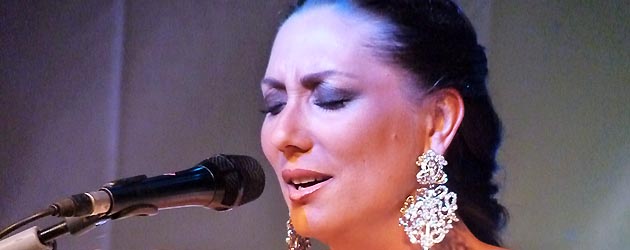Text and photos: Estela Zatania
Saturday, August 2nd, 2014. 10:30pm. Colegio Salesianos, Morón de la Frontera
Cante: Francisco Manuel Pajares, Juan Villar, Marina Heredia, Cancanilla de Marbella. Solo guitar: Sergio González, Juan Luis López. Accompaniment guitar: Niño Jero “Periquín”, José Quevedo “Bolita”, Chaparro de Málaga. Carmen Lozano’s group with Paco Iglesias and Rubén Romero, guitar, Rafael de Utrera, cante, Makarines, chorus and compás.
On the poster it read “XLVIII Gazpacho Andaluz”, which translates into 48 annual editions of the flamenco festival of Morón de la Frontera, one of the oldest and best-known of its kind.
Like nearly all these events, year after year the venerable festival must overcome serious obstacles to put together a respectable program with limited resources. Since July 19th, a series of parallel activities has been held, including the noteworthy photographic exhibit “Flamenco Project”, permanently ceded to the city by its creator, Steve Kahn, and currently on view at the new Espacio Santa Clara.
There wasn’t massive attendance for the festival compared to other years, and the weather was no help: a cold wind blew through the patio of the Salesianos Colegio the five hours of the program, and only the most hardy stuck it out till the end.
Despite the various obstacles, the organization managed to compose a solid program based on the classic flamenco fans prefer in this corner of the interior of lower Andalucía. As in other years, and reflecting the guitar culture in this town, the evening began with a guitar soloist. Young Sergio González, a prized student of Paco Delgado, showed with his guajiras and bulerías that guitar has continuity in Morón, and ended with the most recognizable flamenco falseta of all time, the one that Diego del Gastor made his own adapting it from an old guajira of Manolo de Badajoz.
The winner of the third flamenco singing contest for young people, Francisco Manuel Pajares from Extremadura, surprised us all with his strong creative delivery of cantiñas, siguiriyas and bulerías, where we would have enjoyed more flavor of the singer’s origins.
The young hopeful was followed by the grand veteran of the program, Juan Villar with his inseparable Periquín on guitar. He navigated the depths of soleá and siguiriya with his natural strength, not based on lung power. The warm patina of his voice, and his intensity, feel more like Jerez than Cádiz. Juan is in a fine stage of artistic maturity. In tangos, the singer did not limit his repertoire to Cádiz styles, not at all. Fandangos, and then he closed his performance with cuplé that became “cante jondo”.
Marina Heredia, “the voice of the Albaicín” as the master of ceremonies Pedro Ortiz described her. Her radiant youth and beauty have little to do with female singers of decades ago, and her singing also reflects contemporary freshness. Her regular guitarist, José Quevedo “Bolita”, escorted her through soleá; he’s a brilliant musician although at times he upstages the singer. In malagueñas Marina ended with abandolao including, of course, a fandango of Albaicín with that bulerías spin some young interpreters now give. She sang the caña at a brisk tempo, and her performance, up to this point merely competent, began to get exciting with tasty tangos that included a lot of Camarón material. In bulerías, Bolita let loose his Jerez feeling and Marina again demonstrated that the festive forms are her strong point.
A moving tribute to veteran dancer Matilde Coral with the presence of Morón’s mayor, and the presidents of the two flamenco associations included the presentation of various gifts, a bouquet of flowers for the honored lady and a few pointed words from Matilde herself who even did a little armwork that reminded us of this dancer’s importance in the recent history of flamenco dance.
Another guitar soloist, Juan Luis López, opened the second part with a mini recital of soleá, guajiras and bulerías. And you begin to notice that although these guitarists play the characteristic notes and riffs of Morón, the famous pulsation and phrasing have been lost and it all reminds you of Paco de Lucía whose influence and genius weigh heavily in today’s flamenco guitar.
Cancanilla de Marbella. Knowledge, personality and power. He sang traditional forms and verses of soleá and siguiriyas. With a lot of repertoire and always generous with his singing, he dedicated some fandangos to singer Enrique Extremeño. Cancanilla ended with bulerías where he even squeezed in the “reniego” siguiriya, and ended with his original way of dancing. Guitarist Chaparro de Málaga who accompanied him is from the school of “never take your eyes off the singer for a nanosecond”, and the result was well worth the effort.
The group of local dancer Carmen Lozano, with Paco Iglesias and Rubén Romero on guitar, and Rafael de Utrera and the Makarines putting the vocals and the compás, closed out this edition of the Gazpacho Andaluz.
